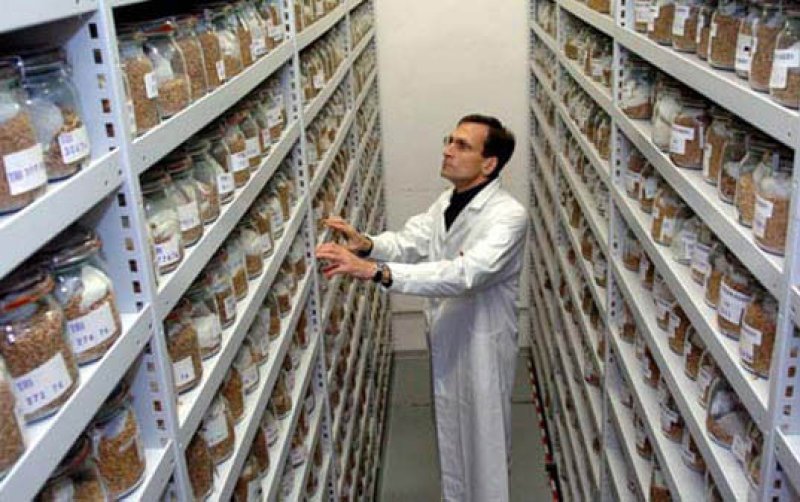As anti-GMO activists relentlessly focus on “organic” alternatives as better than food that’s genetically modified, their rancor casts a shadow over other important uses of genetics in growing food. Seed banks, which are held in high esteem by organic supporters and many advocacy groups as a source of “natural” diversity, can more effectively meet diversity needs–with the use of, yes, genetics.
There’s no time to lose. Currently, it’s estimated that the earth contains 300,000 species of edible flowering plants. But of that number, we only consume about a dozen. And of that dozen, farmers, processors and producers tend to concentrate on just a few varieties within each species. Meanwhile, the human population of the planet continues to grow, with more mouths to feed and less land to grow food.
Around the world, 1,700 seed banks currently store hundreds of thousands of crop and local domestic seeds, as well as wild relatives of crops. Many of these varieties of seeds are no longer used. But they contain the biodiversity we will probably need to double the amount of food we produce over the next 25 years, while resisting pressures like climate change, bad soil, drought and land shortages.
Today’s advances in genetics can unlock the diversity in these seed banks like never before. Susan McCouch, a plant geneticist at Cornell University, advocates several approaches that could make this diversity a more integrated part of modern agriculture:
- Gather sequencing information from the genes of every sample currently in a seed bank (McCouch believes this could amount to 2 million sequences). Then, such whole-genome sequencing could aid in searching for genetic connections that make for hardier hybrid plants. Discovering which genetic traits and sequences help plants to adapt to a number of environmental conditions could create a “parts list” that can determine which sequences can thrive in which conditions.
- Match sequence data with phenotypes, environmental and geographic information for banked seeds to develop field trials of newly bred plants. Sometimes, these matches will bring together weeds, cultivated varieties or even disparate species—whatever works is the goal. “This will make plant breeding faster, more efficient, and cheaper,” she wrote in Nature.
- Improve bioinformatics so that genomic information can be more easily shared among gene bank managers, researchers, farmers and plant breeders. Currently, this information exists in different, unique information systems, and sharing is difficult.
McCouch is no opponent of GMOs. She points to GMOs as a key to slowing world hunger and malnutrition. In fact, her proposal to merge genetics and seed banks involves “remodeling of cropping systems,” which can include genetic modification. But her point is that GM isn’t the be-all and end-all technique of finding better genetic variants. In fact, it’s just one of many.
But the pace of innovative plant breeding is slowing down. The perceived cost of doing these extensive genetic analyses is partly to blame. While the cost of genomic sequencing has plummeted since the Human Genome Project, for example, genome wide sequencing is still not exactly cheap. Another cause is the fact that plant breeding programs can still take a long time to eliminate undesirable traits and enhance desirable ones. And finally, breeding has been hijacked by the political and ideological debate over GMOs, and in particular the anti-technology impact of the embrace of the precautionary approach by the Convention on Biological Diversity; the PP is adored by opponents of GMOs. In this case, the CBD makes sharing genetic material of cultivated and wild plants (among other organisms) very difficult, throwing up obstacles to efforts to find new and effective plant hybrids.
Anti-GMO critics, even from otherwise level headed academic institutions, still make claims that patents stifle the ability of farmers to share seeds, even though plant patents have existed for long before genetic modification and seed patents are limited in time. In addition, so-called “seed sovereignty” can come from new versions of seeds of plants, whether patented or not.
Genetic techniques come a long way in certain areas
- In Egypt, researchers using genomic markers to search for desired traits in the endangered medicinal plant Hypericum sinaicum found that banked seeds could more than double the diversity seen in the plants.
- In India, new crossbred varieties of rice were found to be more tolerant of salt, an issue because of increased seawater encroachment on rice farms. The new breed of rice was the result of combining the genetics of a cultivated rice variety with that of a wild type rice plant. This breeding was done the “traditional” way, comparing 34,000 crosses to, after about four years, come up with one successful, germinating embryo.
Seed banking began about 30 years ago as an improvement to individual farmers storing and using their own seeds. But seed banking’s potential has not been tapped. Today’s genetic approaches (including next-generation sequencing, tracking expression of beneficial traits, and genetic modification) can use these banks to expand our repertoire of what we can grow, and where and when we can grow it.
Andrew Porterfield is a writer, editor and communications consultant for academic institutions, companies and non-profits in the life sciences. He is based in Camarillo, California. Follow @AMPorterfield on Twitter.































